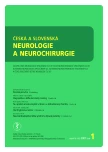The Effects of Bilateral Narrowing the Internal Carotid Artery on the Cerebrovascular Reserve Capacity of the Posterior Cerebrovascular System
Authors:
P. Ševčík 1; J. Polívka 1; V. Rohan 1; Z. Hess 2
Authors‘ workplace:
Neurologická klinika FN Plzeň
1; II. interní klinika FN Plzeň
2
Published in:
Cesk Slov Neurol N 2007; 70/103(1): 67-71
Category:
Short Communication
Overview
The bilateral narrowing of the internal carotid artery has significant effects on the cerebral hemodynamics and cerebrovascular reserve capacity (CVR). Our study aimed at determining the degree of influencing the hemodynamics of the posterior cerebrovascular system in patients with these affection by means of measuring cerebrovascular reserve capacity using transcranial dopplerometry and CO2.
The study involved 20 patients with bilateral stenosis of the internal carotid artery > 80 %, one of which was symptomatic. Transcranial dopplerometry was used for monitoring the changed velocity of blood flow in the middle cerebral arteries (ACM) and in the basillary artery (BA) in response to the inhalation of exogenous CO2.
Eighteen patients (90 %) demonstrated decreased CVR in BA (-10.5 up to 23.2 %/ kPa CO2, the normal value of CVR in BA is 31.0 - 5.9 %/kPa CO2). Out of these subjects, three patients showed negative value of CVR in BA (-10.5, - 9.8, -5.0 %/kPa CO2). These patients had also depleted CVR in ACM (1.4, 2.4, 0.9 %/kPa CO2). However, quite normal value of CVR in BA (26.4, 26.9 %/kPa CO2) was found out in two patients.
CVR in BA in patients with the bilaterally narrowed internal carotid artery may be various, ranging from quite normal up to negative values. In the future the investigations of CVR in BA could serve for the better evaluation of the degree of hemodynamic affection to the posterior circulation at stenoses of internal carotid arteries.
Key-words:
cerebrovascular arterial reserve, cerebrovascular reactivity, autoregulation, cerebral blood flow, ultrasonography, transcranial dopplerometry
Sources
1. Powers WJ. Cerebral hemodynamics in ischemic cerebrovascular disease. Ann Neurol 1991; 29 : 231–40.
2. Derdeyn CP, Videen TO, Yundt KD et al. Variability of cerebral blood volume and oxygen extraction: stages of cerebral hemodynamic impairment revisited. Brain 2002; 125 : 595–607.
3. Baron JC, Bousser MG, Rey A et al. Reversal of focal "misery-perfusion syndrome" by extra-intracranial arterial bypass in hemodynamic cerebral ischemia: a case study with 15-O positron emission tomography. Stroke 1981; 12 : 454–59.
4. Marshall RS, Lazar RM, Pile-Spellman J et al. Recovery of brain function during induced cerebral hypoperfusion. Brain 2001; 124 : 1208–17.
5. Grubb RL, Derdeyn CP, Fritsch SM et al. Importance of hemodynamic factors in the prognosis of symptomatic carotid occlusion. JAMA 1998; 280 : 1055–60.
6. Rutgers DR, Klijn CJM, Kapelle LJ et al. Sustained Bilateral Hemodynamic Benefit of Contralateral Carotid Endarterectomy in Patients With Symptomatic Internal Carotid Artery Occlusion. Stroke 2001; 32 : 728-34.
7. Keunen RW, Tavy DL, Visee HF et al. A transcranial Doppler study of basilar hemodynamics in progressive carotid artery disease. Neurol Res 1998; 20 : 493-8.
8. Barrett KM, Ackerman RH, Gahn G et al. Basilar and middle cerebral artery reserve: a comparative study using transcranial Doppler and breath-holding techniques. Stroke 2001; 32 : 2793–6.
9. Park CHW, Sturzenegger M, Douville C et al. Autoregulatory Response and CO2 Reactivity of the Basilar Artery. Stroke 2003; 34 : 34.
10. Hunink MGM, Polak JF, Barlan MM et al. Detection and quantification of carotid artery stenosis: efficacy of various Doppler velocity parameters. AJR 1993; 160 : 619-25.
11. Anderson GB, Ashforth R, Steinke DE et al. CT angiography for the detection and characterization of carotid artery bifurcation disease. Stroke 2000; 31 : 2168–74.
12. Naidich TP, Righi AM. Neurovascular imaging. Radiol Clin North Am 1995; 33 : 115-66.
13. Kastruj A, Dichgans J, Niemeier M et al. Changes of cerebrovascular CO2 reactivity during normal aging. Stroke 1998; 29 : 1311–4.
14. Ševčík P, Polívka J, Hess Z. Cerebrovaskulární rezerva bazilární a střední mozkové tepny. Komparativní studie s použitím transkraniální doplerometrie a CO2. Čes a Slov Neurol Neurochir 2005; 68/101(6): 378–81.
15. Ševčík P, Polívka J, Hess Z et al. Reprodukovatelnost měření indexu CO2-reaktivity mozkových tepen pomocí transkraniální doplerometrie. Čes a Slov Neurol Neurochir 2006; 69/102(1): 39–44.
16. Liebeskind DS. Collateral circulation. Stroke 2003; 34 : 2279.
17. Widder B. Cerebral vasoreactivity. In: Hennerici M, Meairs S (Eds). Cerebrovascular ultrasound. Theory, practice and future developments. Cambridge (UK): Cambridge University Press 2001 : 324-34.
18. Škoda O. Transkraniální dopplerovská sonografie. In: Školoudík D, Škoda O, Bar M et al (Eds). Neurosonologie. Praha: Galén 2003 : 157-9.
19. Dumville J, Panerai RB, Lennard NS et al. Can cerebrovascular reactivity be assessed without measuring blood pressure in patients with carotid artery disease? Stroke 1998; 29 : 968-74.
20. Ursino M, Minassian AT, Lodi CA et al. Cerebral hemodynamics during arterial and CO2 pressure changes: in vivo prediction by a mathematical model. Am J Physiol Heart Circ Physiol 2000; 279: H2439-55.
21. Gao E, Zouny WL, Spellman JP et al. Mathematical considerations for modeling cerebral blood flow autoregulation to systemic arterial pressure. Am J Physiol 1998; 274: H1023-31.
22. Derdeyn CP, Videen TO, Fritsch SM et al. Compensatory mechanisms for chronic cerebral hypoperfusion in patients with carotid occlusion. Stroke 1999; 30 : 1019–24.
23. Widder B, Kleiser B, Krapf H. Course of cerebrovascular reactivity in patients with carotid artery occlusions. Stroke 1994; 25 : 1963–7.
Labels
Paediatric neurology Neurosurgery NeurologyArticle was published in
Czech and Slovak Neurology and Neurosurgery

2007 Issue 1
Most read in this issue
- Panic Disorder – Neuropsychiatric Profile
- The Liquor Tau Protein and Beta Amyloid in Alzheimer’s Disease
- Diagnosis and treatment of leptomeningeal carcinomatosis in solid tumors
- Surgical treatment of the metastatic cervical spine tumours
